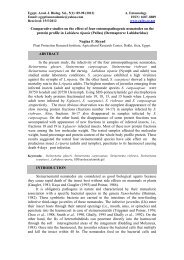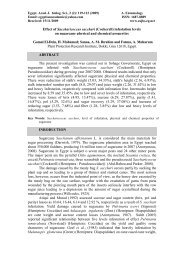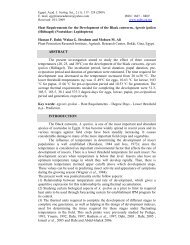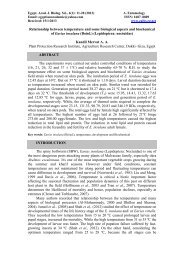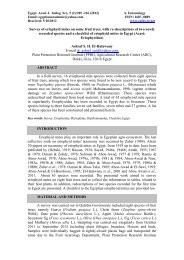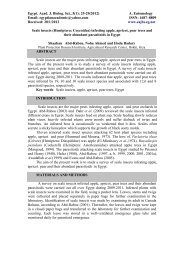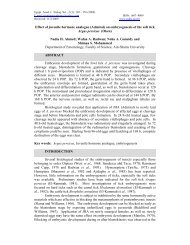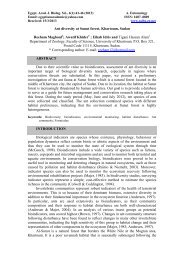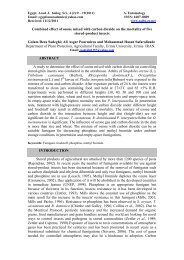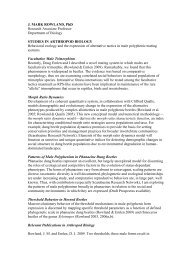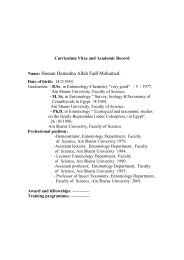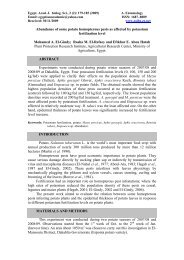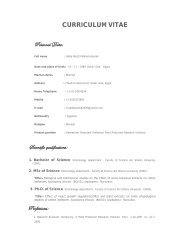Effect of some insecticides on the immature stages of the egg ...
Effect of some insecticides on the immature stages of the egg ...
Effect of some insecticides on the immature stages of the egg ...
You also want an ePaper? Increase the reach of your titles
YUMPU automatically turns print PDFs into web optimized ePapers that Google loves.
Egypt. Acad. J. biolog. Sci., 3 (1): 31- 38(2010) A. Entomology<br />
Email: egyptianacademic@yahoo.com ISSN: 1687–8809<br />
Received: 30/3/2010 www.eajbs.eg.net<br />
<str<strong>on</strong>g>Effect</str<strong>on</strong>g> <str<strong>on</strong>g>of</str<strong>on</strong>g> <str<strong>on</strong>g>some</str<strong>on</strong>g> <str<strong>on</strong>g>insecticides</str<strong>on</strong>g> <strong>on</strong> <strong>the</strong> <strong>immature</strong> <strong>stages</strong> <str<strong>on</strong>g>of</str<strong>on</strong>g> <strong>the</strong> <strong>egg</strong> parasitoid<br />
Trichogramma evanescens West. (Hym., Trichogrammatidae )<br />
M<strong>on</strong>a A. Shoeb<br />
Department <str<strong>on</strong>g>of</str<strong>on</strong>g> Biological C<strong>on</strong>trol. Plant protecti<strong>on</strong> Institute, Agric. Res. Centre.<br />
ABSTRACT<br />
The effect <str<strong>on</strong>g>of</str<strong>on</strong>g> five <str<strong>on</strong>g>insecticides</str<strong>on</strong>g>, Pr<str<strong>on</strong>g>of</str<strong>on</strong>g>ect (w.p.), CAPL- 2, Lambda-cyhalothrin,<br />
Spinosad, and Fenitrothi<strong>on</strong> ( Sumith<strong>on</strong>) <strong>on</strong> <strong>the</strong> <strong>immature</strong> <strong>stages</strong> <str<strong>on</strong>g>of</str<strong>on</strong>g> <strong>the</strong> first and <strong>the</strong><br />
sec<strong>on</strong>d generati<strong>on</strong>s <str<strong>on</strong>g>of</str<strong>on</strong>g> <strong>the</strong> <strong>egg</strong> parasitoid Trichogramma evanescens was studied in<br />
laboratory at 25 ± 1 0 C, 65± 5% R.H. and 12:12 L:D. The study was carried out <strong>on</strong><br />
parasitized <strong>egg</strong>s <strong>on</strong>e, two, four and eight days post parasitism. Results showed that: 1)<br />
L<strong>on</strong>gevity <str<strong>on</strong>g>of</str<strong>on</strong>g> <strong>the</strong> emerged parasitoid was affected by <strong>the</strong> tested <str<strong>on</strong>g>insecticides</str<strong>on</strong>g>. The<br />
recorded values <str<strong>on</strong>g>of</str<strong>on</strong>g> <strong>the</strong> adult l<strong>on</strong>gevity emerged from treated <strong>egg</strong>s ranged from 12 hrs<br />
to 7 days ( for females ) and from 12 hrs to 4 days (for males). Treating <strong>egg</strong>s with<br />
chemical <str<strong>on</strong>g>insecticides</str<strong>on</strong>g> caused death <str<strong>on</strong>g>of</str<strong>on</strong>g> <strong>the</strong> emerged adults within few hours post<br />
emergence when <strong>the</strong> treatment was carried out 4 days post parasitism or <strong>on</strong>e day<br />
before adult emergence. 2). The number <str<strong>on</strong>g>of</str<strong>on</strong>g> host <strong>egg</strong>s turned to black (<strong>the</strong> parasitoid<br />
larvae developed to pupae) varied according to timing <str<strong>on</strong>g>of</str<strong>on</strong>g> treatment. 3). Adult<br />
emergence rate varied according to <strong>the</strong> used insecticide, <strong>the</strong> parasitoid stage and <strong>the</strong><br />
generati<strong>on</strong>. 4) No parasitoids emerged from parasitized <strong>egg</strong>s treated with CAPL-2. 5).<br />
There was no emergence for <strong>the</strong> parasitoid treated with Lambda-cyhalothrin,<br />
spinosad, and fenitrothi<strong>on</strong> (Sumith<strong>on</strong>) <strong>on</strong>e, two or four days after parasitism.<br />
However, emergence was recorded with very low percentages when <strong>the</strong> <strong>egg</strong>s were<br />
treated 24 hrs before parasitoid emergence. 6) Female percentage slightly decreased in<br />
<strong>the</strong> adults emerged from paeasitized <strong>egg</strong>s treated with chemicals.<br />
Keyword: Insecticides, parasitoid, Trichogramma evanescens<br />
INTRODUCTION<br />
Recently, plant protecti<strong>on</strong> strategy has recommended, minimizing <strong>the</strong> use <str<strong>on</strong>g>of</str<strong>on</strong>g><br />
chemical pesticides. It is very important to study <strong>the</strong> side effect <str<strong>on</strong>g>of</str<strong>on</strong>g> <str<strong>on</strong>g>insecticides</str<strong>on</strong>g> <strong>on</strong> <strong>the</strong><br />
natural enemies to exclude <strong>the</strong> <strong>on</strong>es that have detrimental effect <strong>on</strong> such natural<br />
enemies. Trichogramma spp. have been extensively used as biological c<strong>on</strong>trol agent.<br />
Hassan (1982) and Bigler (1983, 1984 ) reported that 65 – 93% reducti<strong>on</strong> in larval<br />
infestati<strong>on</strong>s <str<strong>on</strong>g>of</str<strong>on</strong>g> <strong>the</strong> Europian corn borer, Ostrinia nubilalis in corn fields was achieved<br />
following Trichogramma releases during 1970 in Germany and Switzerland. Vornin<br />
and Grinbert (1981) reported a positive reducti<strong>on</strong> <str<strong>on</strong>g>of</str<strong>on</strong>g> pests such as Loxstege spp.<br />
Agrotis spp. and Ostrinia spp. following Trichogramma releases. In China significant<br />
reducti<strong>on</strong>s in populati<strong>on</strong>s <str<strong>on</strong>g>of</str<strong>on</strong>g> Ostrinia spp., Heliothis spp. and Cnophalocis spp. as<br />
well as in crop damage were obtained by using Trichogramma as a biological c<strong>on</strong>trol<br />
agent, (Li, 1984). In Egypt, T. evanescens has been used successfully since 1984 as a<br />
bioc<strong>on</strong>trol agent against different insect pests; <strong>the</strong> sugar-cane borer, Chilo agamen<strong>on</strong><br />
<strong>on</strong> sugar-cane and rice, <strong>the</strong> olive pest Prays oleae, <strong>the</strong> peach bud borer, Anarsia<br />
lineatella <strong>on</strong> peach and apricot, <strong>the</strong> grape-fruit worm, Lopezia botrana and <strong>the</strong> date<br />
fruit worms, Ephestia spp. <strong>on</strong> date palms (Abbas, 2004). Faria (2000) stated that<br />
Trichogramma pretiosum Riley, was applied in Brazil for <strong>the</strong> c<strong>on</strong>trol <str<strong>on</strong>g>of</str<strong>on</strong>g> several pests<br />
in corn, cassava and cott<strong>on</strong> crops. Fur<strong>the</strong>rmore, in <strong>the</strong> tomato crop, <strong>the</strong> c<strong>on</strong>trol <str<strong>on</strong>g>of</str<strong>on</strong>g> <strong>the</strong>
32<br />
M<strong>on</strong>a A. Shoeb<br />
moth, Tuta absoluta was carried out in <str<strong>on</strong>g>some</str<strong>on</strong>g> countries, through inundative releases<br />
<str<strong>on</strong>g>of</str<strong>on</strong>g> T. pretiosum (Amaya-Navarro, 1988; Faria., 1992; Haji, 1996, 1997). The<br />
utilizati<strong>on</strong> <str<strong>on</strong>g>of</str<strong>on</strong>g> selective <str<strong>on</strong>g>insecticides</str<strong>on</strong>g> is a reas<strong>on</strong>able strategy in pest management,<br />
because it favors <strong>the</strong> c<strong>on</strong>servati<strong>on</strong> <str<strong>on</strong>g>of</str<strong>on</strong>g> natural enemies in <strong>the</strong> agro-ecosystem (Carvalho<br />
et al., 1999). Works aiming to study <strong>the</strong> physiological selectivity <str<strong>on</strong>g>of</str<strong>on</strong>g> different chemical<br />
groups <str<strong>on</strong>g>of</str<strong>on</strong>g> pesticides to Trichogramma spp. were accomplished. Cônsoli et al. (1998),<br />
by evaluating <strong>the</strong> effects <str<strong>on</strong>g>of</str<strong>on</strong>g> several <str<strong>on</strong>g>insecticides</str<strong>on</strong>g> <strong>on</strong> <strong>the</strong> <strong>immature</strong> <strong>stages</strong> <str<strong>on</strong>g>of</str<strong>on</strong>g> T.<br />
pretiosum, c<strong>on</strong>cluded that phenthoate and cartap were harmful, lambda-cyalothrin and<br />
abamectin had moderate effect, tebufenozid and teflubenzur<strong>on</strong> were harmless to<br />
slightly harmful. Brunner et al. (2001), using Potter’s tower, sprayed <str<strong>on</strong>g>insecticides</str<strong>on</strong>g> <strong>on</strong><br />
adults <str<strong>on</strong>g>of</str<strong>on</strong>g> T. platneri Nagarkatti up to two days old and observed that <strong>the</strong> compounds<br />
oxamyl, imidacloprid and Bacillus thuringiensis var. kurstaki caused 100% mortality<br />
48 hours after spraying, while selectivity was observed for diflubenzur<strong>on</strong>, fenoxycarb<br />
and tebufenozide.<br />
The present study deals with <strong>the</strong> effect <str<strong>on</strong>g>of</str<strong>on</strong>g> five insecticide groups, Pr<str<strong>on</strong>g>of</str<strong>on</strong>g>ect W.P.<br />
(biocide), CAPL-2 (mineral oil), Lambda-cyhalothrin, spinosad, and fenitrothi<strong>on</strong><br />
(Sumith<strong>on</strong>) <strong>on</strong> <strong>the</strong> <strong>immature</strong> <strong>stages</strong> <str<strong>on</strong>g>of</str<strong>on</strong>g> <strong>the</strong> <strong>egg</strong> parasitoid T. evanescens (1, 2, 4 days<br />
post parasitism, and <strong>on</strong>e day before adult emergence) under laboratory c<strong>on</strong>diti<strong>on</strong>s <str<strong>on</strong>g>of</str<strong>on</strong>g><br />
25±1 o C, 65±5% R.H. and 12:12 L:D.<br />
MATERIAL AND METHOD<br />
The tested <str<strong>on</strong>g>insecticides</str<strong>on</strong>g>:<br />
1- Pr<str<strong>on</strong>g>of</str<strong>on</strong>g>ect 7% W.P. (bioside group) c<strong>on</strong>tains Spodoptera Littoralis NPV 2% and<br />
Bacillus thuringensis 6%. Product <str<strong>on</strong>g>of</str<strong>on</strong>g> Plant Protecti<strong>on</strong> Research Institute,<br />
applied at 300 gm/feddan.<br />
2- CAPL-2: 96.62 % (V.V.) (mineral oil group) applied at 1.5 %.<br />
3- Fenitrothi<strong>on</strong> (Sumith<strong>on</strong>), organophosphate insecticide, applied at 0.375%<br />
4- Lambda-cyhalothrin (pyrethriod group): Formulati<strong>on</strong> is Karate 1 EC (Zeneca,<br />
Wilmingt<strong>on</strong>, DE) with c<strong>on</strong>centrati<strong>on</strong> 478.2 mg /ml, applied at 0.187 %<br />
5- Spinosad. The commercial product Tracer (24% spinosad, suspensi<strong>on</strong><br />
c<strong>on</strong>centrate, Dow Agroscience, Egypt) was used in this study, applied at 0.037<br />
%. (Mandour, 2009).<br />
The host and <strong>the</strong> parasitoid:<br />
Both Sitotroga. cerealella <strong>egg</strong>s and Trichogramma evanescens were obtained<br />
from <strong>the</strong> mass rearing unit at <strong>the</strong> Department <str<strong>on</strong>g>of</str<strong>on</strong>g> Biological C<strong>on</strong>trol. Plant Protecti<strong>on</strong><br />
Institute, Agric. Res. Centre.<br />
Procedure<br />
Fresh Sitotroga cerealella <strong>egg</strong>s (less than 24 h. old) were glued <strong>on</strong>to carto<strong>on</strong><br />
cards, each c<strong>on</strong>tained nearly 500 <strong>egg</strong>s. These cards were placed in glass tubes. Newly<br />
emerged T. evanescens adults were transferred to <strong>the</strong> glass tubes c<strong>on</strong>taining S.<br />
cerealella <strong>egg</strong>-cards and kept for 24 hrs. The exposed <strong>egg</strong>s were divided into five<br />
groups; <strong>the</strong> 1 st group was treated with <strong>the</strong> tested <str<strong>on</strong>g>insecticides</str<strong>on</strong>g> 24 h after parasitism, 2 nd<br />
group was treated 48 h after parasitism, 3 rd group was treated four days after<br />
parasitism, 4 th group was treated eight days after parasitism (<strong>on</strong>e day before adult<br />
emergence), while <strong>the</strong> 5 th group was treated with water after parasitism to serve as a<br />
c<strong>on</strong>trol. Treatment <str<strong>on</strong>g>of</str<strong>on</strong>g> parasitized <strong>egg</strong>s (<strong>egg</strong>-cards) was carried out by a 0.5 L sprayer<br />
c<strong>on</strong>taining 100 ml <str<strong>on</strong>g>of</str<strong>on</strong>g> <strong>the</strong> insecticide soluti<strong>on</strong>s at <strong>the</strong> above menti<strong>on</strong>ed c<strong>on</strong>centrati<strong>on</strong>s.<br />
The treated <strong>egg</strong>s were kept <strong>on</strong> paper-sheets until drying. All <strong>the</strong> five groups were<br />
kept in glass tubes, and checked daily for emergence <str<strong>on</strong>g>of</str<strong>on</strong>g> <strong>the</strong> adult parasitoids. Droplets
<str<strong>on</strong>g>Effect</str<strong>on</strong>g> <str<strong>on</strong>g>of</str<strong>on</strong>g> <str<strong>on</strong>g>some</str<strong>on</strong>g> <str<strong>on</strong>g>insecticides</str<strong>on</strong>g> <strong>on</strong> <strong>the</strong> <strong>immature</strong> <strong>stages</strong> <str<strong>on</strong>g>of</str<strong>on</strong>g> <strong>the</strong> <strong>egg</strong> parasitoid T. evanescens 33<br />
<str<strong>on</strong>g>of</str<strong>on</strong>g> h<strong>on</strong>ey were scattered <strong>on</strong> <strong>the</strong> inner surface <str<strong>on</strong>g>of</str<strong>on</strong>g> <strong>the</strong> tube's walls as food for <strong>the</strong><br />
parasitoid.<br />
Biological aspects <str<strong>on</strong>g>of</str<strong>on</strong>g> <strong>the</strong> emerged parasitoids<br />
The following biological aspects were studied for <strong>the</strong> parasitoids emerged<br />
from treated parasitized <strong>egg</strong>s: average number <str<strong>on</strong>g>of</str<strong>on</strong>g> black <strong>egg</strong>s (c<strong>on</strong>taining parasitoids'<br />
pupae), emergence rate, l<strong>on</strong>gevity <str<strong>on</strong>g>of</str<strong>on</strong>g> adults, and female percentage.<br />
Each group was tested for <strong>the</strong> ability <str<strong>on</strong>g>of</str<strong>on</strong>g> emerged females to parasitize new<br />
untreated host <strong>egg</strong>s, (sec<strong>on</strong>d generati<strong>on</strong> (GII), and <strong>the</strong> previous biological aspects<br />
were determined for <strong>the</strong> sec<strong>on</strong>d generati<strong>on</strong> (if any).<br />
The experimental design used was completely randomized with six treatments<br />
five <str<strong>on</strong>g>insecticides</str<strong>on</strong>g> and a c<strong>on</strong>trol (15 replicates for each treatment and 100 <strong>egg</strong>s for each<br />
replicate).<br />
- Statistical analysis was achieved using <strong>the</strong> SPSS S<str<strong>on</strong>g>of</str<strong>on</strong>g>tware.<br />
RESULTS AND DISCUSSION<br />
CAPL-2: The parasitized <strong>egg</strong>s treated with CAPL-2 <strong>on</strong>e day post parasitism did not<br />
turn black (<strong>the</strong> parasitoid larvae died and did not develop to pupal stage). Similarly,<br />
<strong>the</strong> parasitized <strong>egg</strong>s treated 8 days post parasitism did not give rise to adult<br />
parasitoids. C<strong>on</strong>sequently, <strong>the</strong>re were no available adult parasitoids to c<strong>on</strong>duct studies<br />
<strong>on</strong> <strong>the</strong> 2 nd generati<strong>on</strong> (GII).<br />
Pr<str<strong>on</strong>g>of</str<strong>on</strong>g>ect 7%: The bio-insecticide was found to have c<strong>on</strong>siderable detrimental effect <strong>on</strong><br />
<strong>the</strong> development <str<strong>on</strong>g>of</str<strong>on</strong>g> <strong>the</strong> parasitoid inside <strong>the</strong> treated host <strong>egg</strong>s. The recorded values for<br />
<strong>the</strong> number <str<strong>on</strong>g>of</str<strong>on</strong>g> black <strong>egg</strong>s were (44.4, 44.1, 41.3 and 39.2 for <strong>the</strong> GI & 42.1, 39.2,<br />
41.4 and 34.1 for GII, compared to 67.2, 66.1, 68.3, 65.1 for <strong>the</strong> c<strong>on</strong>trol), for <strong>the</strong><br />
<strong>egg</strong>s treated 1, 2, 4 and 8 days post parasitizati<strong>on</strong>, respectively. The respective values<br />
for <strong>the</strong> emergence rate for GII decreased compared to GI and <strong>the</strong> c<strong>on</strong>trol, <strong>the</strong><br />
recorded values were 68%, 62%, 63%, 61% for GI & 54%, 50%, 48%, 42% for GII,<br />
compared to 77%, 75%, 75%, 77% for <strong>the</strong> c<strong>on</strong>trol. The l<strong>on</strong>gevity and sex ratio did not<br />
differ significantly from those recorded for <strong>the</strong> c<strong>on</strong>trol.<br />
Fenitrothi<strong>on</strong> (Sumith<strong>on</strong>): Treatment with this chemical insecticide caused a highly<br />
decrease in <strong>the</strong> emergence rate, <strong>the</strong> recorded values were 0% - 16% compared to 73%<br />
-77% for <strong>the</strong> c<strong>on</strong>trol. Also this chemical caused death <str<strong>on</strong>g>of</str<strong>on</strong>g> <strong>the</strong> emerged adults within<br />
few hours post emergence (0–1 day) compared to (4–7 days) for <strong>the</strong> c<strong>on</strong>trol so no data<br />
were recorded for <strong>the</strong> sec<strong>on</strong>d generati<strong>on</strong>.<br />
Lambda-cyhalothrin: The number <str<strong>on</strong>g>of</str<strong>on</strong>g> black <strong>egg</strong>s was slightly affected, but <strong>the</strong><br />
emergence rate highly decreased compared to <strong>the</strong> c<strong>on</strong>trol. The recorded values for <strong>the</strong><br />
emergence rate were (31% and 23%) for those treated <strong>on</strong>e and two days post<br />
pararsitism, while no emergence was recorded for those treated 4 and 8 days post<br />
parasitism compared to (73% - 77%) for <strong>the</strong> c<strong>on</strong>trol. As for <strong>the</strong> sec<strong>on</strong>d generati<strong>on</strong>,<br />
<strong>the</strong> emergence rates were 39% and 40% when treatment was <strong>on</strong>e and two days post<br />
parasitism.<br />
Spinosad: The emergence rate for all treatments was very low (3-5%) and <strong>the</strong><br />
emerged adults died within 6-12hrs after emergence. It was noticed that <strong>the</strong> two<br />
c<strong>on</strong>centrati<strong>on</strong>s <str<strong>on</strong>g>of</str<strong>on</strong>g> Spinosad gave <strong>the</strong> same effect <strong>on</strong> <strong>the</strong> <strong>immature</strong> <strong>stages</strong> <str<strong>on</strong>g>of</str<strong>on</strong>g> <strong>the</strong> <strong>egg</strong><br />
parasitoid T. evanescens (same number <str<strong>on</strong>g>of</str<strong>on</strong>g> black <strong>egg</strong>s – same emergence rate – same<br />
percentage <str<strong>on</strong>g>of</str<strong>on</strong>g> females – same l<strong>on</strong>gevity for females and males)<br />
Statistical analysis, showed highly significant differences <str<strong>on</strong>g>of</str<strong>on</strong>g> black <strong>egg</strong>s between <strong>the</strong><br />
c<strong>on</strong>trol and all <strong>the</strong> studied <str<strong>on</strong>g>insecticides</str<strong>on</strong>g>. As for comparing <str<strong>on</strong>g>insecticides</str<strong>on</strong>g> with each o<strong>the</strong>r<br />
<strong>the</strong>re were significant and insignificant differences between each o<strong>the</strong>r for <strong>the</strong>
Insecticides<br />
34<br />
M<strong>on</strong>a A. Shoeb<br />
numbers <str<strong>on</strong>g>of</str<strong>on</strong>g> black <strong>egg</strong>s as well as emergence rates (Table 1). The differences in<br />
percentages <str<strong>on</strong>g>of</str<strong>on</strong>g> females between <strong>the</strong> tested <str<strong>on</strong>g>insecticides</str<strong>on</strong>g> and <strong>the</strong> c<strong>on</strong>trol were significant<br />
(Table 2).<br />
Table (1): Number <str<strong>on</strong>g>of</str<strong>on</strong>g> black <strong>egg</strong>s and emergence rate <str<strong>on</strong>g>of</str<strong>on</strong>g> <strong>the</strong> <strong>egg</strong> parasitoid Trichogramma. evanescens<br />
treated with five <str<strong>on</strong>g>insecticides</str<strong>on</strong>g>. (n =20)<br />
Insecticides<br />
CAPL-2<br />
fenitrothio<br />
(Sumith<strong>on</strong>)<br />
Pr<str<strong>on</strong>g>of</str<strong>on</strong>g>ect<br />
(w.p.).<br />
Lambdacyhalothrin<br />
Spinosad<br />
C<strong>on</strong>trol<br />
CAPL-2<br />
fenitrothio<br />
(Sumith<strong>on</strong>)<br />
Pr<str<strong>on</strong>g>of</str<strong>on</strong>g>ect<br />
(w.p.).<br />
Lambdacyhalothrin<br />
One – day<br />
120<br />
Time <str<strong>on</strong>g>of</str<strong>on</strong>g> treatment after parasitism (days )<br />
Two - days<br />
Four - days<br />
Eight – days<br />
No <str<strong>on</strong>g>of</str<strong>on</strong>g> black <strong>egg</strong>s Emer. Rate % No <str<strong>on</strong>g>of</str<strong>on</strong>g> black <strong>egg</strong>s Emer. Rate % No <str<strong>on</strong>g>of</str<strong>on</strong>g> black <strong>egg</strong>s Emer. Rate % No <str<strong>on</strong>g>of</str<strong>on</strong>g> black <strong>egg</strong>s Emer. Rate %<br />
G I<br />
G II<br />
G I<br />
G II<br />
0.0 == == === 0.0 === === ===<br />
43.2±3.1<br />
b<br />
44.2±3.1<br />
b<br />
44.2±3.7<br />
b<br />
38±1.7<br />
c<br />
67.2±2.5<br />
a<br />
0.0<br />
42.2±3.1<br />
b<br />
36.1±3.3<br />
c<br />
0.0<br />
67.2±2.5<br />
a<br />
16±1.8%<br />
b<br />
68±4.8%<br />
b<br />
31±2.2%<br />
c<br />
3±0.7%<br />
d<br />
77±4.1%<br />
a<br />
===<br />
54±3%<br />
b<br />
40±1.8%<br />
c<br />
===<br />
77±4.1%<br />
a<br />
G I<br />
45.1±3.2<br />
b<br />
44.1±3.2<br />
b<br />
42±2.2<br />
c<br />
40±3.1<br />
d<br />
66.1±3.1<br />
a<br />
G II<br />
0.0<br />
39.2±3.9<br />
b<br />
34.2±3.2<br />
c<br />
0.0<br />
66.1±3.1<br />
a<br />
G I<br />
12±2 %<br />
d<br />
62±2 %<br />
b<br />
2±2.43%<br />
C<br />
3±0.9%<br />
e<br />
73±4.%<br />
a<br />
G II<br />
===<br />
50±3.6%<br />
b<br />
39±3.9%<br />
c<br />
==<br />
73±4.%<br />
a<br />
G I<br />
44.2±3.2<br />
b<br />
40.3±2.6<br />
c<br />
41.3±2.6<br />
c<br />
37.2±3.3<br />
d<br />
38±2.7<br />
d<br />
68.3±2.3<br />
a<br />
G II<br />
G I<br />
G II<br />
=== 0.0 ===<br />
0.0 0.0 ====<br />
41.4±3.9<br />
b<br />
63±3.9%<br />
b<br />
48±4.1%<br />
b<br />
=== 0.0 ===<br />
0.0<br />
68.3±2.3<br />
a<br />
8±.0.7%<br />
c<br />
75.3±2.9<br />
a<br />
===<br />
75.3±2.9<br />
a<br />
G I<br />
45.2±2.1<br />
b<br />
41.2±3.1<br />
c<br />
39.2±3.1<br />
c<br />
35.2±3.2<br />
d<br />
33±3.2<br />
e<br />
65.2±2.3<br />
a<br />
G II<br />
G I<br />
G II<br />
== 0.0 ===<br />
0.0<br />
34.1±2.2<br />
b<br />
15±1.9%<br />
c<br />
61±3.9%<br />
b<br />
===<br />
42±1.8%<br />
b<br />
=== 0.0 ===<br />
LS D 2.02 1.71 1,79 1.67 1.69 1.55 1.60 1.67 1.84 1.31 0.99 1.18 1.98 1.15 1.48 0.99<br />
Means with <strong>the</strong> same letter are not significantly different GI = first generati<strong>on</strong> GII= sec<strong>on</strong>d generati<strong>on</strong><br />
Table (2): L<strong>on</strong>gevity (days) and female percentage <str<strong>on</strong>g>of</str<strong>on</strong>g> <strong>the</strong> <strong>egg</strong> parasitoid Trichogramma. evanescens<br />
treated with five <str<strong>on</strong>g>insecticides</str<strong>on</strong>g>. (n =20)<br />
One – day<br />
Time <str<strong>on</strong>g>of</str<strong>on</strong>g> treatment after parasitism (days )<br />
Two - days<br />
Four - days<br />
Means with <strong>the</strong> same letter are not significantly different F = female M = male GI = first generati<strong>on</strong><br />
GII= sec<strong>on</strong>d generati<strong>on</strong><br />
Vianna et al. (2009) studied <strong>the</strong> toxicity <str<strong>on</strong>g>of</str<strong>on</strong>g> certain <str<strong>on</strong>g>insecticides</str<strong>on</strong>g> to Trichogramma spp.<br />
and <strong>the</strong>ir effect <strong>on</strong> descendant generati<strong>on</strong>. They reported that <strong>the</strong> parasitism rates were<br />
reduced, also <strong>the</strong> females emerged from <strong>egg</strong>s treated with <str<strong>on</strong>g>insecticides</str<strong>on</strong>g> were not able<br />
to lay <strong>egg</strong>s. Shoeb (2005), studied <strong>the</strong> effect <str<strong>on</strong>g>of</str<strong>on</strong>g> <str<strong>on</strong>g>insecticides</str<strong>on</strong>g> <strong>on</strong> T. evanescens and<br />
found that pr<str<strong>on</strong>g>of</str<strong>on</strong>g>en<str<strong>on</strong>g>of</str<strong>on</strong>g>os and <strong>the</strong> natural oil, K-Z, were harmful to <strong>the</strong> <strong>immature</strong> <strong>stages</strong> <str<strong>on</strong>g>of</str<strong>on</strong>g><br />
<strong>the</strong> parasitoid while <strong>the</strong> bio-insecticide, Protecto (Bacillus Thuringiensis.) had <strong>the</strong><br />
least deleterious effect. L<strong>on</strong>gevity <str<strong>on</strong>g>of</str<strong>on</strong>g> adults emerged from <strong>the</strong> treated <strong>egg</strong>s did not<br />
differ significantly from that <str<strong>on</strong>g>of</str<strong>on</strong>g> <strong>the</strong> c<strong>on</strong>trol. It was interesting that K-Z oil was found<br />
to be detrimental to <strong>the</strong> parasitoid with almost similar effect <str<strong>on</strong>g>of</str<strong>on</strong>g> <strong>the</strong> chemical<br />
insecticide. This fact could be interpreted as K-Z oil may c<strong>on</strong>tain a toxic material<br />
which harms <strong>the</strong> parasitoid, or <strong>the</strong> oil, covering <strong>the</strong> <strong>egg</strong>-shell, prevents oxygen from<br />
<strong>the</strong> <strong>egg</strong> and <strong>immature</strong>s. Kawamura et al. (2001) studied <strong>the</strong> toxicity <str<strong>on</strong>g>of</str<strong>on</strong>g> six<br />
<str<strong>on</strong>g>insecticides</str<strong>on</strong>g>, acephate, methomyl, eth<str<strong>on</strong>g>of</str<strong>on</strong>g>enprox, cartap, chlorfluazur<strong>on</strong>, and Bacillus<br />
0.0<br />
65.2±2.3<br />
a<br />
3±0.7%<br />
d<br />
77±29.%<br />
a<br />
Eight – days<br />
L<strong>on</strong>gevity ( days ) Female % L<strong>on</strong>gevity ( days ) Female % L<strong>on</strong>gevity ( days ) Female % L<strong>on</strong>gevity ( days ) Female %<br />
G I<br />
G II<br />
G I<br />
G II<br />
G I<br />
G II G I G II G I G II G I G II<br />
G I<br />
G II<br />
==<br />
77±29.%<br />
a<br />
G I G II<br />
=== == == === === === === === === === ==== === === == === ===<br />
1.0 === 49±0.8%<br />
d<br />
F 7, M 4 F 6, M 3 65±2.2%<br />
b<br />
F 6, M 3 F 6, M 3 59±2.2%<br />
c<br />
Spinosad 12 hrs 0.0 65±4.4%<br />
b<br />
C<strong>on</strong>trol F 7, M 4 F 7, M 4 68±2.1%<br />
a<br />
=== 1.0 === 52±2 %<br />
c<br />
64±1.8%<br />
b<br />
55±3.2%<br />
c<br />
F 7, M 4 F 7, M 3 62±2.3%<br />
b<br />
F 6, M 3 F 6, M 3 63±2.2%<br />
b<br />
==== 12 hrs 0.0 61±3.6%<br />
b<br />
68±2.1%<br />
a<br />
F 7, M 4 F 7, M 4 63±2.%<br />
a<br />
=== === === === ==== 1.0 === 54±1.8%<br />
c<br />
64±3.9%<br />
b<br />
49±2.4%<br />
b<br />
F 6, M 4 F 6, M 4 63±3.9%<br />
b<br />
68±3.9%<br />
b<br />
F 6, M 4 F 7, M 4 61±3.9%<br />
b<br />
=== === === === === === === ==<br />
==== 6 hrs 0.0 62±2.9%<br />
b<br />
63±2.%<br />
a<br />
F 7, M 4 F 7, M 4 65±2.2.%<br />
a<br />
=== 6 hrs 0.0 55±3.4%<br />
c<br />
65±2.2.%<br />
a<br />
F 7, M 4 F 7, M 4 67±2%<br />
a<br />
===<br />
62±3.9%<br />
b<br />
===<br />
67±2%<br />
a
<str<strong>on</strong>g>Effect</str<strong>on</strong>g> <str<strong>on</strong>g>of</str<strong>on</strong>g> <str<strong>on</strong>g>some</str<strong>on</strong>g> <str<strong>on</strong>g>insecticides</str<strong>on</strong>g> <strong>on</strong> <strong>the</strong> <strong>immature</strong> <strong>stages</strong> <str<strong>on</strong>g>of</str<strong>on</strong>g> <strong>the</strong> <strong>egg</strong> parasitoid T. evanescens 35<br />
thuringiensis (Bt) to different developmental <strong>stages</strong> <str<strong>on</strong>g>of</str<strong>on</strong>g> Trichogramma dendrolimi.<br />
The results indicated that each <str<strong>on</strong>g>of</str<strong>on</strong>g> <strong>the</strong> <str<strong>on</strong>g>insecticides</str<strong>on</strong>g> tested showed different degrees <str<strong>on</strong>g>of</str<strong>on</strong>g><br />
toxicity to <strong>the</strong> parasitoid. Eth<str<strong>on</strong>g>of</str<strong>on</strong>g>enprox showed <strong>the</strong> highest toxicity followed by cartap.<br />
compared to <strong>the</strong> o<strong>the</strong>r <str<strong>on</strong>g>insecticides</str<strong>on</strong>g>. The development <str<strong>on</strong>g>of</str<strong>on</strong>g> <strong>the</strong> parasitoids in <strong>egg</strong>s treated<br />
with <strong>the</strong>se two <str<strong>on</strong>g>insecticides</str<strong>on</strong>g> was normal, similar to that <str<strong>on</strong>g>of</str<strong>on</strong>g> <strong>the</strong> c<strong>on</strong>trol group. Only <strong>the</strong><br />
emergence <str<strong>on</strong>g>of</str<strong>on</strong>g> adult wasps from host <strong>egg</strong>s was disturbed. Adult female wasps, which<br />
emerged from host <strong>egg</strong>s treated with such two <str<strong>on</strong>g>insecticides</str<strong>on</strong>g> had <strong>the</strong> ability to oviposit<br />
normally. Vianna et al. (2009) studied <strong>the</strong> effect <str<strong>on</strong>g>of</str<strong>on</strong>g> nine <str<strong>on</strong>g>insecticides</str<strong>on</strong>g> used in tomato<br />
producti<strong>on</strong> <strong>on</strong> adults <str<strong>on</strong>g>of</str<strong>on</strong>g> two populatios <str<strong>on</strong>g>of</str<strong>on</strong>g> Trichogramma pretiosum Riley. They<br />
reported that Bacillus thuringiensis, lufenur<strong>on</strong> and triflumur<strong>on</strong> had <strong>the</strong> lowest<br />
negative effects <strong>on</strong> parasitism; however, abamectin and pyrethroids (betacyflurin 50<br />
and esfenvalerate) <str<strong>on</strong>g>insecticides</str<strong>on</strong>g> reduced parasitism rates. T. pretiosum emerged from<br />
A. kuehniella <strong>egg</strong>s treated with esfenvalerate were not able to parasitize untreated<br />
<strong>egg</strong>s <str<strong>on</strong>g>of</str<strong>on</strong>g> this host. Geraldo et al. (2003) reported that: Abamectin, lufenur<strong>on</strong> and<br />
pirimicarb decreased <strong>the</strong> lifetime <str<strong>on</strong>g>of</str<strong>on</strong>g> females exposed during <strong>the</strong> <strong>egg</strong> or larval stage.<br />
The capacity <str<strong>on</strong>g>of</str<strong>on</strong>g> parasitism was significantly reduced by all <strong>the</strong> products when females<br />
were treated in pupal stage. Jayf et al. (2001), reported that pesticides were evaluated<br />
for <strong>the</strong>ir effect <strong>on</strong> two parasitoid species, Colpoclypeus florus and Trichogramma<br />
platner. Results indicated that spinosad was moderately toxic at 10% and highly toxic<br />
at 100% <str<strong>on</strong>g>of</str<strong>on</strong>g> <strong>the</strong> recommended rate. Adeney et al. (2008), reported that Esfenvalerate<br />
7.5 and spinosad 24 grams/ ha were harmful to all <strong>immature</strong> <strong>stages</strong> <str<strong>on</strong>g>of</str<strong>on</strong>g> T.pretiosum.<br />
Negative results with spinosad <strong>on</strong> parasitoids from <strong>the</strong> genus Trichogramma were also<br />
reported by Canete (2005). Chares et al. (2000), reported that spinosad and<br />
prophen<str<strong>on</strong>g>of</str<strong>on</strong>g>os were <strong>the</strong> most toxic compounds to T. exiguum adults, followed by<br />
lambda cyhalothrin, cypermethrin, and thiodicarb. Plewka et al. (1975), also reported<br />
that <str<strong>on</strong>g>some</str<strong>on</strong>g> <str<strong>on</strong>g>insecticides</str<strong>on</strong>g> did not penetrate <strong>the</strong> host <strong>egg</strong>-chori<strong>on</strong> (Sitotroga cerealella),<br />
and Trichogramma spp. were affected <strong>on</strong>ly up<strong>on</strong> emergence from <strong>the</strong> <strong>egg</strong>s. Delpuech<br />
and Meyet ( 2003 ), reported that <strong>the</strong>re was a decrease in sex ratio for <strong>the</strong> <str<strong>on</strong>g>of</str<strong>on</strong>g>fspring <str<strong>on</strong>g>of</str<strong>on</strong>g><br />
treated females. This decrease in sex ratio was interpreted to be resulting from a<br />
decrease in fertilized <strong>egg</strong>s due to <strong>the</strong> perturbati<strong>on</strong> <str<strong>on</strong>g>of</str<strong>on</strong>g> nerve transmissi<strong>on</strong>s induced by<br />
<strong>the</strong> insecticide. On <strong>the</strong> o<strong>the</strong>r hand, Suh et al. (2000), reported that, regardless <str<strong>on</strong>g>of</str<strong>on</strong>g> <strong>the</strong><br />
developmental stage treated, n<strong>on</strong>e <str<strong>on</strong>g>of</str<strong>on</strong>g> <strong>the</strong> <str<strong>on</strong>g>insecticides</str<strong>on</strong>g> tested had a significant effect <strong>on</strong><br />
<strong>the</strong> sex ratio.<br />
Thus, this study gives important results that will help to choose <strong>the</strong> best<br />
pesticide to be applied since products with <strong>the</strong> lowest impact <strong>on</strong> biological c<strong>on</strong>trol<br />
agents are <strong>the</strong> most appropriate to be used in IPM programs. However, it is important<br />
to point out that this research was carried out under laboratory c<strong>on</strong>diti<strong>on</strong>s where <strong>the</strong><br />
parasitoid was submitted to <strong>the</strong> highest possible pesticide pressure, <strong>the</strong>n, under field<br />
c<strong>on</strong>diti<strong>on</strong>s pesticides might have <strong>the</strong>ir negative impact reduced because <strong>the</strong> biological<br />
c<strong>on</strong>trol agents can benefit from natural shelters or avoid treated areas. Moreover,<br />
sunlight degradati<strong>on</strong> plays an important role in <strong>the</strong> field that also helps to decrease <strong>the</strong><br />
impact <str<strong>on</strong>g>of</str<strong>on</strong>g> pesticides <strong>on</strong> <strong>the</strong> beneficial arthropods observed in laboratory (Rocha &<br />
Carvalho, 2004).<br />
ACKNOWLEDGMENTS<br />
My deep thanks to Pr<str<strong>on</strong>g>of</str<strong>on</strong>g>. Dr. M. S. T. Abbas, Chief researchers in Department<br />
<str<strong>on</strong>g>of</str<strong>on</strong>g> Biological C<strong>on</strong>trol, Plant protecti<strong>on</strong> Institute, Agric. Res. Centre for valuable<br />
advice during this study
36<br />
REFERENCES<br />
M<strong>on</strong>a A. Shoeb<br />
Abbas M. S. T. (2004). Successful applicati<strong>on</strong>s <str<strong>on</strong>g>of</str<strong>on</strong>g> Trichogramma evanescens (West.)<br />
for c<strong>on</strong>trolling certain insect pests in Egypt. 1 st Arab C<strong>on</strong>ference <str<strong>on</strong>g>of</str<strong>on</strong>g> Applied<br />
Biological Pest C<strong>on</strong>trol, Cairo, Egypt, 5-7 April 2004: 148 (Abstract).<br />
Amaya-Navarro, M., (1988). Biological c<strong>on</strong>trol <str<strong>on</strong>g>of</str<strong>on</strong>g> Scrobipalpula absoluta (Meyrick)<br />
by Trichogramma sp. in <strong>the</strong> tomato (Lycopersic<strong>on</strong> esculentum Mill.). In:<br />
Internati<strong>on</strong>al Symposium <strong>on</strong> Trichogramma and O<strong>the</strong>r Egg Parasites, 2.,<br />
1986, Guangzhou. Anais. Paris: INRA, 43:453-458.<br />
Adeney de Freitas Bueno, Regiane Cristina Oliveira de Freitas Bueno, José Roberto<br />
Postali Parra, and Sim<strong>on</strong>e Silva Vieira, (2008). <str<strong>on</strong>g>Effect</str<strong>on</strong>g>s <str<strong>on</strong>g>of</str<strong>on</strong>g> pesticides used in<br />
soybean crops to <strong>the</strong> <strong>egg</strong> parasitoid Trichogramma pretiosum. Ciência Rural,<br />
Santa Maria, 38(6): 1495-1503.<br />
Bibler F., 1984. Mass producti<strong>on</strong> and field applicati<strong>on</strong> <str<strong>on</strong>g>of</str<strong>on</strong>g> Trichogramma maidis<br />
Pintureau & Voegele against <strong>the</strong> European corn borer in Switzerland. Abstract<br />
vol.XVII Intern. C<strong>on</strong>g. Ent. Hamburg, Germany p. 788-796<br />
Bigler F., (1983). Erfahrungen bie der biologischen Bekam fung Maiszunslers mir<br />
Trichogramma. Schlupfwespen in der Schweitz Mitt. Landwirtsch, 31(1-2):<br />
14-22.<br />
Brunner, J.F. (2001). <str<strong>on</strong>g>Effect</str<strong>on</strong>g> <str<strong>on</strong>g>of</str<strong>on</strong>g> pesticides <strong>on</strong> Colpoclypeus florus<br />
Hymenoptera: Eulophidae) and Trichogramma platneri (Hymenoptera:<br />
Trichogrammatidae), parasitoids <str<strong>on</strong>g>of</str<strong>on</strong>g> leafrollers in Washingt<strong>on</strong>. J. Ec<strong>on</strong>.<br />
Entomol., Maryland, 94(5): 1075-1084.<br />
Cañete, C. L. (2005). Seletividade de inseticidas a espécies de Trichogramma<br />
(Hymenoptera: Trichogrammatidae), 106f. Dissertação (Mestrado em<br />
Zoologia) - Universidade Federal do Paraná, Curitiba, PR<br />
Carvalho, G. A.; Parra, J. R. P. and Baptista, G. C. (1999). Ação residual de alguns<br />
inseticidas pulverizados em plantas de tomateiro sobre duas linhagens de<br />
Trichogramma pretiosum Riley, (Hymenoptera: Trichogrammatidae) em casadevegetação<br />
Agrotec., Lavras, 23(4) : 770-775.<br />
Charles, P. C.; Orr d, B. and Van, D. J. W. (2000). <str<strong>on</strong>g>Effect</str<strong>on</strong>g> <str<strong>on</strong>g>of</str<strong>on</strong>g> <str<strong>on</strong>g>insecticides</str<strong>on</strong>g> <strong>on</strong><br />
Trichogramma exiguum (Trichogrammatidae: Hymenoptera) preimaginal<br />
development and adult survival. J. <str<strong>on</strong>g>of</str<strong>on</strong>g> ec<strong>on</strong>o. Entomol,. 93(3): 577-583.<br />
C<strong>on</strong>soli, F. L.; Parra, J.R.P. and Hassan S. A. (1998). Side-effects <str<strong>on</strong>g>of</str<strong>on</strong>g> <str<strong>on</strong>g>insecticides</str<strong>on</strong>g> used<br />
in tomato fields <strong>on</strong> <strong>the</strong> <strong>egg</strong> parasitoid Trichogramma pretiosum Riley (Hym.,<br />
Trichogrammatidae), a natural enemy <str<strong>on</strong>g>of</str<strong>on</strong>g> Tuta absoluta (Meyrick) (Lep.,<br />
Gelechiidae). J. Appl. Entomol., Berlin, 122(1&2):43-47.<br />
Delpuech, J. M. and Meyet, J. (2003). Reducti<strong>on</strong> in <strong>the</strong> Sex Ratio <str<strong>on</strong>g>of</str<strong>on</strong>g> <strong>the</strong> Progeny <str<strong>on</strong>g>of</str<strong>on</strong>g> a<br />
Parasitoid Wasp (T. brassicae) Surviving <strong>the</strong> Insecticide Chlorpyrifos.<br />
Archives <str<strong>on</strong>g>of</str<strong>on</strong>g> Envir<strong>on</strong>mental C<strong>on</strong>taminati<strong>on</strong> and Toxicology. 45: 203-208.<br />
Faria, Jr. P.A.J. (2000). Resposta funci<strong>on</strong>al de Trichogramma pretiosum Riley Tuta<br />
absoluta (Meyrick) (Lepidoptera: Gelechiidae), efeitoda idade do hospedeiro:<br />
An. Soc. Entomol. Bras., Itabuna, 29(1): 85-93.<br />
Faria, Jr. P. A. J. (1992). C<strong>on</strong>trole biológico da traça do tomateiro pela "FRUTINOR".<br />
In: Simpósio de C<strong>on</strong>trole Biológico, Águas de Lindóia. Anais. Jaguariúna:<br />
Embrapa, CNPDA, p.61-63.<br />
Geraldo, A. C., Paulo R. R., Luiz C. D. R., Jair C. M., Loriney C. F. and Carvalho C.<br />
E., 2003. Side-effects <str<strong>on</strong>g>of</str<strong>on</strong>g> <str<strong>on</strong>g>insecticides</str<strong>on</strong>g> used in tomato fields <strong>on</strong> Trichogramma<br />
pretiosum (Hymenoptera, Trichogrammatidae). Acta Scientiarum. Agr<strong>on</strong>omy<br />
Maringá, 25(2):275-279.
<str<strong>on</strong>g>Effect</str<strong>on</strong>g> <str<strong>on</strong>g>of</str<strong>on</strong>g> <str<strong>on</strong>g>some</str<strong>on</strong>g> <str<strong>on</strong>g>insecticides</str<strong>on</strong>g> <strong>on</strong> <strong>the</strong> <strong>immature</strong> <strong>stages</strong> <str<strong>on</strong>g>of</str<strong>on</strong>g> <strong>the</strong> <strong>egg</strong> parasitoid T. evanescens 37<br />
Haji, F.N.P. (1996). C<strong>on</strong>trole biológico da traça do tomateiro, com uso de<br />
Trichogramma, na região do submédio São Francisco. In:<br />
SIMPÓSIO DE CONTROLE BIOLÓGICO, 5, 1996, Foz do Iguaçu. Anais.<br />
L<strong>on</strong>drina: EMBRAPA, CNPSo, p.355-360.<br />
Haji, F.N.P. (1997). C<strong>on</strong>trole biológico da traça do tomateiro com Trichogramma no<br />
Nordeste do Brasil. In: PARRA, J.R.P.; ZUCCHI, R.A. Trichogramma e o<br />
c<strong>on</strong>trole biologic aplicado. Piracicaba: FEALQ, cap.12:319-324.<br />
Hassan N. A., 1982. Mass producti<strong>on</strong> and utilizati<strong>on</strong> <str<strong>on</strong>g>of</str<strong>on</strong>g> Trichogramma. 3 results <str<strong>on</strong>g>of</str<strong>on</strong>g><br />
<str<strong>on</strong>g>some</str<strong>on</strong>g> research projects related to <strong>the</strong> practical use in <strong>the</strong> Federal Republic <str<strong>on</strong>g>of</str<strong>on</strong>g><br />
Germany. Les Trichogramma. Colleagues INRA 9: 213:18.<br />
Jay, F. B.; John, E. D.; Michael D. D. and El-Izabeth H. B. (2001). <str<strong>on</strong>g>Effect</str<strong>on</strong>g> <str<strong>on</strong>g>of</str<strong>on</strong>g><br />
Pesticides <strong>on</strong> Colpoclypeus florus (Hymenoptera: Eulophidae) and<br />
Trichogramma platneri (Hymenoptera: Trichogrammatidae), Parasitoids <str<strong>on</strong>g>of</str<strong>on</strong>g><br />
Leafrollers in Washingt<strong>on</strong>. J. ec<strong>on</strong>. Entomol., 94( 5): 1075-1084.<br />
Kawamura, S.; Takada, Y.; Tanaka, T. J. (2001). <str<strong>on</strong>g>Effect</str<strong>on</strong>g>s <str<strong>on</strong>g>of</str<strong>on</strong>g> various <str<strong>on</strong>g>insecticides</str<strong>on</strong>g> <strong>on</strong> <strong>the</strong><br />
development <str<strong>on</strong>g>of</str<strong>on</strong>g> <strong>the</strong> <strong>egg</strong> parasitoid Trichogramma dendrolimi (Hymenoptera:<br />
Trichogrammatidae). J. Ec<strong>on</strong>. Entomol.; 94(6): 1340-3<br />
Li L., (1984). Research and utilizati<strong>on</strong> <str<strong>on</strong>g>of</str<strong>on</strong>g> Trichogramma in China, Im. P. L. Adkiss<strong>on</strong><br />
& Ma Shijun (eds) Proe. Chinese Aead Sci. Joint U. S. Nat. Acad. Sci. Symp.<br />
On Biological C<strong>on</strong>trol <str<strong>on</strong>g>of</str<strong>on</strong>g> Insects. Science press, Beijing, China, P. 204-23.<br />
Mandour, N. S. (2009). Influence <str<strong>on</strong>g>of</str<strong>on</strong>g> spinosad <strong>on</strong> <strong>immature</strong> and adult <strong>stages</strong> <str<strong>on</strong>g>of</str<strong>on</strong>g><br />
Chrysoperla carnea (Stephens) (Neuroptera: Chrysopidae). BioC<strong>on</strong>trol<br />
springer : 54:93-102.<br />
Plewka, T.; Kot, J. and Krukierek, T. (1975). <str<strong>on</strong>g>Effect</str<strong>on</strong>g> <str<strong>on</strong>g>of</str<strong>on</strong>g> <str<strong>on</strong>g>insecticides</str<strong>on</strong>g> <strong>on</strong> <strong>the</strong> l<strong>on</strong>gevity<br />
and fecundity <str<strong>on</strong>g>of</str<strong>on</strong>g> Trichogramma evanescens (Hymenoptera:<br />
Trichogrammatidae). Pol. Ecol. Stud. 1: 197- 210.<br />
Rocha, L.C.D. and Carvalho, G. A, (2004). Adaptação da metodologia padrão da<br />
IOBC para estudos de seletividade com Trichogramma pretiosum Riley, 1879<br />
(Hymenoptera: Trichogrammatidae) em c<strong>on</strong>dições de laboratório. Acta<br />
Scientiarum Agr<strong>on</strong>omy, 26(3): 315-320.<br />
Shoeb, M<strong>on</strong>a A., (2005). Comparativeness <str<strong>on</strong>g>of</str<strong>on</strong>g> chemical, natural and bacterial<br />
<str<strong>on</strong>g>insecticides</str<strong>on</strong>g> <strong>on</strong> <str<strong>on</strong>g>some</str<strong>on</strong>g> biological aspects <str<strong>on</strong>g>of</str<strong>on</strong>g> <strong>the</strong> <strong>egg</strong> parasitoid Trichogramma<br />
evanescens (West.) J. Agric. Sci. Mansoura Univ., 30(8): 4821-4826.<br />
Suh, C. P.C.; David, B. O. and John, W. V. D., (2000). <str<strong>on</strong>g>Effect</str<strong>on</strong>g> <str<strong>on</strong>g>of</str<strong>on</strong>g> Insecticides <strong>on</strong><br />
Trichogramma exiguum (Trichogrammatidae: Hymenoptera) Preimaginal<br />
Development and Adult Survival, Jour. <str<strong>on</strong>g>of</str<strong>on</strong>g> Ec<strong>on</strong>. Entom. 93 (3): 577 – 583<br />
Vianna UR, Pratissoli D, Zanuncio JC, Lima ER, Brunner J, Pereira FF, and Serrão<br />
JE. (2009). Insecticide toxicity to Trichogramma pretiosum (Hymenoptera:<br />
Trichogrammatidae) females and effect <strong>on</strong> descendant generati<strong>on</strong>.<br />
Ecotoxicology (L<strong>on</strong>d<strong>on</strong>, England) 18(2):180-6.<br />
Vor<strong>on</strong>in K. F. and Grinberg, A. M. (1981). The current status and prospects <str<strong>on</strong>g>of</str<strong>on</strong>g><br />
Trichogramma Utilizati<strong>on</strong> in <strong>the</strong> USSR. P. 49-51, In. J. R. Couls<strong>on</strong> (ed.). Proe.<br />
Joint American Soviet C<strong>on</strong>f. <strong>on</strong> Use <str<strong>on</strong>g>of</str<strong>on</strong>g> Beneficial Organisms in <strong>the</strong> C<strong>on</strong>trol <str<strong>on</strong>g>of</str<strong>on</strong>g><br />
Crop Pests. Ent. Soc. Amer. College Park, Maryland.
38<br />
Trichogramma<br />
M<strong>on</strong>a A. Shoeb<br />
ARABIC SUMMERY<br />
سنيسنافيا امارجوكيارتلا ليفطل ةلماكلا ريغ راوطلأا<br />
ىلع تافلآا تاديبم ضعب ريثأت<br />
evanescens West.<br />
بيعش ديمحلا دبع ىنم<br />
ىقدلا – ةيعارزلا ثوحبلا زكرم – تاتابنلا ةياقو<br />
دھعم - ةيجولويبلا ةحفاكملا مسق<br />
Pr<str<strong>on</strong>g>of</str<strong>on</strong>g>ect (w.p.), CAPL- 2, Lambda- ) تافلآا تاديبم ريثأت ةساردل ةيلمعم تاسارد ءارجا مت<br />
ليفطل ةلماكلا ريغ راوطلأا ىلع ( cyhalothrin, Spinosad, and Fenitrothi<strong>on</strong> (Sumith<strong>on</strong>)<br />
. نييلاتتم نيليجل كلذو سنيسنافيا امارجوكيارتلا<br />
ليفطب هيلع لفطتملا ( بوبحلا ةشارف ضيب ) ىلمعملا لئاعلا ضيب ةلماعم مت ةساردلا هذھ ىف<br />
هراوطأ ىف ليفطلا نوكي امدنع ىأ)<br />
لفطتلا بقع مايأ 8 و مايأ 4 ، نيموي ، موي دعب سنيسنافيا امارجوكيارتلا<br />
.( ةلماكلا ريغ<br />
-:<br />
نأ جئاتنلا تحضوأ دق و<br />
ضيبلا نم ةجراخلا تايليفطلا ةايح ةرتف ىف ريبك ريثأت ىلا ىدأ تاديبملاب<br />
هيلع لفطتملا ضيبلا ةلماعم -1<br />
7 ىلا ةعاس 12 نم تاديبملاب لماعملا ضيبلا نم ةجراخلا ثانلاا ةايح ةرتف تحوارت ثيح . لماعملا<br />
ةنراقم)<br />
مايأ 4 ىلا ةعاس 12 نم تحوارت دقف روكذلا ةايح ةرتف امأ ، ( مايأ 7 لورتنكلاب ةنراقم)<br />
مايأ<br />
.( مايأ 4 لورتنكلاب<br />
لئاعلا ةضيب لخاد ليفطلا ةقري لوحت)<br />
دوسلأا نوللا ىلا لوحت ىذلا تاديبملاب لماعملا ضيبلا ددع رثأت -2<br />
ةلماعملا ىلا لفطتلا نم ةرتفلا)<br />
هيلع لفطتملا ضيبلا ةلماعم تيقوتب ( ءارذعلا روط ىلا ةقريلا روط نم<br />
.( تاديبملاب<br />
ريغ روطلا – ديبملا عون -:<br />
نم لكب تاديبملاب لماعملا ضيبلا نم ةلماكلا دارفلأا جورخ ةبسن ترثأت<br />
-3<br />
. هتسارد تمت ىذلا ليجلا – لئاعلا ضيب لخاد ليفطلل لماكلا<br />
. ديبمب ( ليفطلا رامعأ نم رمع ىأ ىف ) ضيبلا ةلماعم دنع ليفطلل ةلماكلا دارفلأل جورخ ثدحي مل -4<br />
CAPL- 2<br />
Lambda-cyhalothrin, ) تاديبمب ضيبلا ةلماعم دنع ليفطلل ةلماكلا دارفلأل<br />
جورخ ثدحي مل -5<br />
، نيموي ، موي دعب ضيبلا ةلماعم تمت امدنع كلذو ( pinosad, and fenitrothi<strong>on</strong> (Sumith<strong>on</strong>)<br />
24)<br />
لفطتلا نم مايأ 8 دعب ةلماعملا تمت امدنع ادج ةليئض جورخ بسن تلجس نكلو لفطتلا دعب مايأ 4<br />
.( جورخلا<br />
لبق ةعاس<br />
عيمجل كلذو تاديبملاب لماعملا لئاعلا ضيب نم ةجراخلا دارفلأا نيب ثانلآا بسن ىف ليئض ضافخنا -6<br />
.<br />
تاديبملا عاونأ



